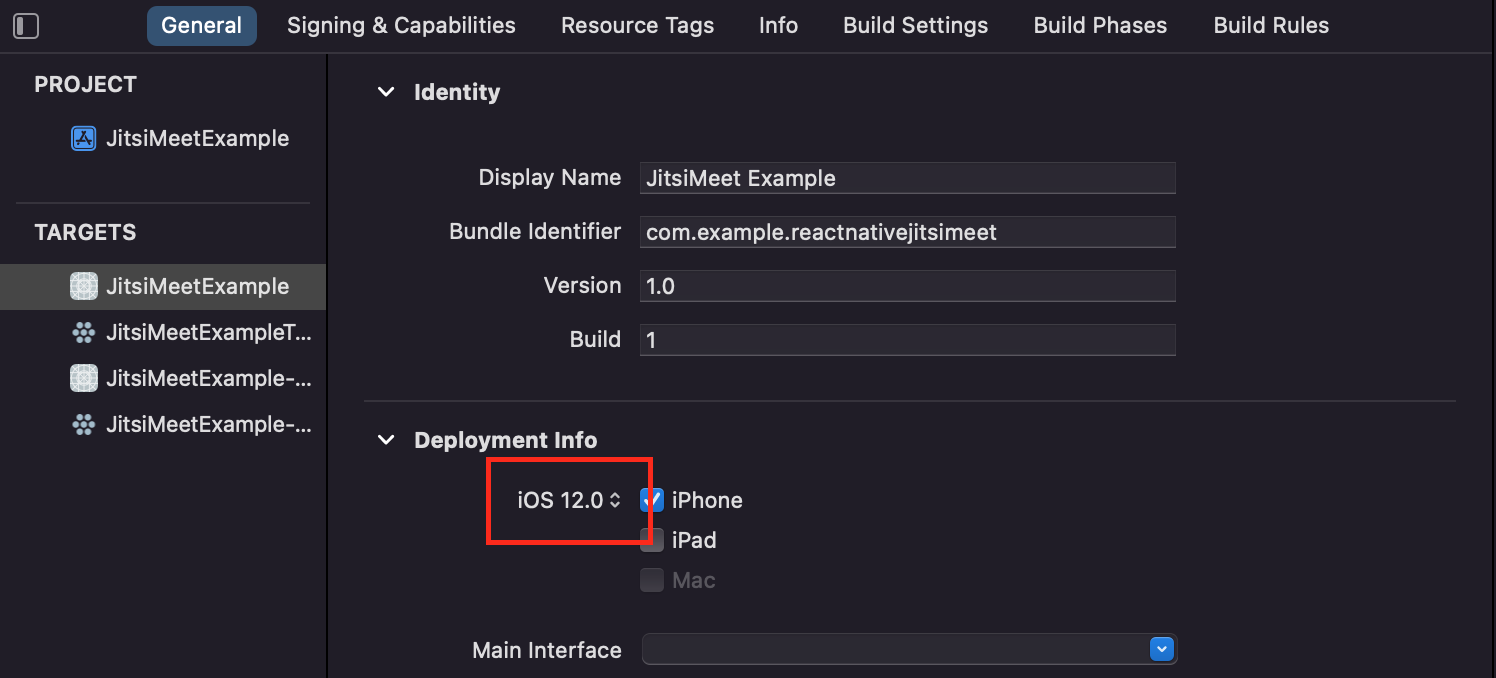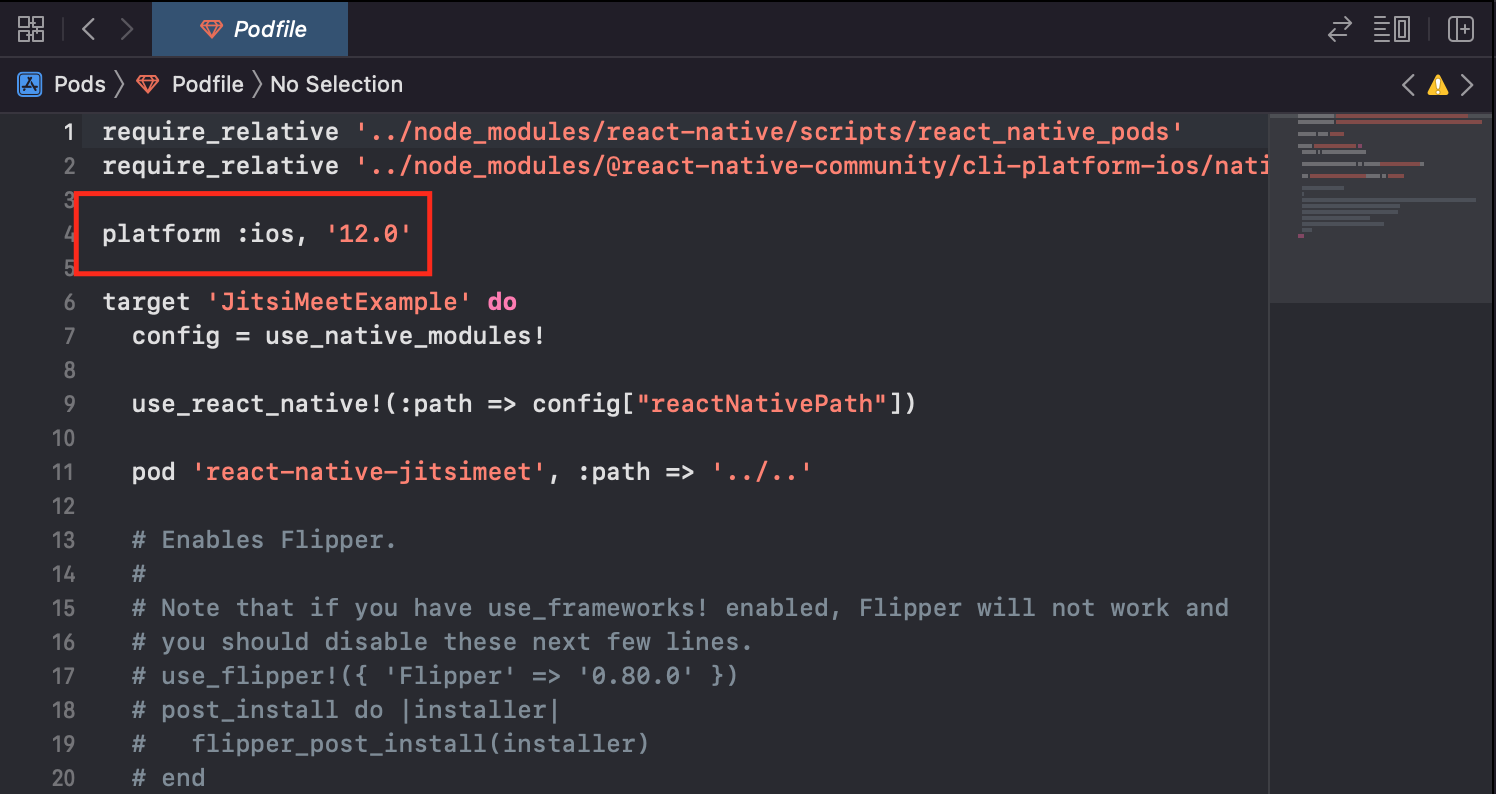React Native Wrapper for Jitsi Meet SDK.
This package is deprecated and will no longer receive any updates. I recommend checking out https://github.com/Zenklub/video-conferece
yarn add @zenklub/react-native-video-conference
or
npm i --save @zenklub/react-native-video-conferenceThe package can be invoked in two modes
- As a new Activity/UIViewController on top of RN Application
- As a RN View
import VideoConference, {
VideoConferenceListener,
CapabilitiesBuilder,
VideoConferenceOptions,
VideoConferenceEvent,
} from '@zenklub/react-native-video-conference';
import React, { useCallback, useRef } from 'react';
import { StyleSheet, View, Pressable, Text } from 'react-native';
const capabilities = new CapabilitiesBuilder().build();
const conferenceOptions: VideoConferenceOptions = {
room: 'ReactNativeJitsiRoom',
serverUrl: 'https://meet.jit.si/',
userInfo: {
name: 'React Native Jitsi Meet Example',
email: 'example@test.com',
avatar: 'https://picsum.photos/200',
},
capabilities: capabilities,
};
function App() {
const eventListener = useCallback((event: VideoConferenceEvent) => {
console.log('EventType', event.type, '\ndata:', event.data);
}, []);
useEffect(() => {
const remove = VideoConferenceListener.addEventListener(eventListener);
return () => remove()
}, [eventListener]);
const startJitsiAsNativeController = async () => {
/*
Mode 1 - Starts a new Jitsi Activity/UIViewController on top of RN Application (outside of JS).
It doesn't require rendering JitsiMeetView Component.
*/
VideoConference.start(conferenceOptions);
/*
Note:
JitsiMeet.launchJitsiMeetView will return a promise, which is resolved once the conference is terminated and the JitsiMeetView is dismissed.
*/
};
/*
The localParticipant leaves the current conference.
*/
const end = () => {
VideoConference.end();
};
return (
<View style={styles.container}>
<Pressable
onPress={startJitsiAsNativeController}
style={({ pressed }) => [
styles.pressable,
{ opacity: pressed ? 0.5 : 1 },
]}
>
<Text style={styles.pressableText}>
Start Jitsi on top of RN Application
</Text>
</Pressable>
</View>
);
}
const styles = StyleSheet.create({
container: {
flex: 1,
alignItems: 'center',
justifyContent: 'center',
},
pressable: {
width: '80%',
borderRadius: 15,
height: 50,
marginVertical: 10,
justifyContent: 'center',
alignItems: 'center',
backgroundColor: 'blue',
},
pressableText: {
fontSize: 17,
fontWeight: 'bold',
textAlign: 'center',
color: '#fff',
},
});
export default App;The other options use VideoConferenceImplementation. Example
import {
VideoConferenceImplementation,
VideoConferenceListener,
CapabilitiesBuilder,
VideoConferenceOptions,
VideoConferenceEvent,
} from '@zenklub/react-native-video-conference';
import React, { useCallback, useRef } from 'react';
import { StyleSheet, View, Pressable, Text } from 'react-native';
const defaultContext = {} as VideoConferenceInterfaceProps;
const VCContext = createContext(defaultContext);
export const VideoConferenceProvider: React.FC = ({ children }) => {
const videoConference = useRef(VideoConferenceInterface.instance());
const [loading, setLoadingState] = useState(false);
const onEvent = useCallback(
(event: VideoConferenceEvent, instance?: VideoConferenceProps) => {
console.log('EventType', event.type, '\ndata:', event.data);
},
[]
);
useEffect(() => {
const remove =
VideoConferenceImplementation.instance().addEventListener(onEvent);
return () => {
remove();
};
}, [onEvent]);
return (
<VCContext.Provider value={videoConference.current}>
{children}
</VCContext.Provider>
);
}
export function useVideoConference() {
const context = useContext(VCContext);
if (context === null) {
throw Error(
'useVideoConference should be used only inside a VideoConferenceProvider'
);
}
return context;
}
const capabilities = new CapabilitiesBuilder().build();
const conferenceOptions: VideoConferenceOptions = {
room: 'ReactNativeJitsiRoom',
serverUrl: 'https://meet.jit.si/',
userInfo: {
name: 'React Native Jitsi Meet Example',
email: 'example@test.com',
avatar: 'https://picsum.photos/200',
},
capabilities: capabilities,
};
export function App() {
const videoConference = useVideoConference();
const startJitsiAsNativeController = async () => {
videoConference.start(conferenceOptions);
};
const end = () => {
videoConference.end();
};
return (
<View style={styles.container}>
<Pressable
onPress={startJitsiAsNativeController}
style={({ pressed }) => [
styles.pressable,
{ opacity: pressed ? 0.5 : 1 },
]}
>
<Text style={styles.pressableText}>
Start Jitsi on top of RN Application
</Text>
</Pressable>
</View>
);
}| Atributo/Método | Descrição |
|---|---|
roomId |
A identificação da videoconferência em andamento. |
sendEvent(event: VideoConferenceEvent) |
Envia um evento da videoconferência para a sessão da conferência. |
start(options: VideoConferenceOptions) |
Inicia uma sessão de videoconferência com as opções especificadas. |
end() |
Encerra a videoconferência em andamento. Lança um erro TerminateConferenceError se ocorrer um erro durante o encerramento. |
addEventListener(listener: VideoConferenceEventListener) |
Adiciona um ouvinte para novos eventos na videoconferência. A função de retorno de chamada do ouvinte recebe um parâmetro de evento do tipo VideoConferenceEvent e a instância da VideoConference. Retorna uma função que pode ser usada para remover o ouvinte atual. |
instance: () => VideoConferenceProps |
Representa uma referência global para a instância da videoconferência. |
See Options for further information.
1.) This library uses Swift code, so make sure that you have created the Objective-C bridging header file.
If not, open your project in Xcode and create an empty Swift file.
Xcode will ask if you wish to create the bridging header file, please choose yes.
For more information check Create Objective-C bridging header file.
2.) Replace the following code in AppDelegate.m (ONLY required for mode 1. If you're using mode 2, skip this step):
...
#import "RNVideoConference/RNVideoConferenceViewController.h"
....UIViewController *rootViewController = [UIViewController new];
rootViewController.view = rootView;
self.window.rootViewController = rootViewController;with this one
RNVideoConferenceViewController *rootViewController = [RNVideoConferenceViewController new];
rootViewController.rnView = rootView;
self.window.rootViewController = rootViewController;or
This will create a navigation controller to be able to navigate between the Jitsi component and your react native screens.
3.) Add the following lines to your Info.plist
<key>NSCameraUsageDescription</key>
<string>Camera Permission</string>
<key>NSMicrophoneUsageDescription</key>
<string>Microphone Permission</string>
<key>NSCalendarUsageDescription</key>
<string>Calendar Permission</string>4.) Modify your platform version in Podfile and Xcode to have platform version 12.0 or above.
5.) In Xcode, under Build settings set Enable Bitcode to No and Always Embed Swift Standard Libraries to Yes.
6.) In Xcode, under Signing & Capabilities add the capability Background Modes and check Voice over IP. Otherwise, it won't work well in background.
7.) Clean your project and run npx pod-install.
1.) In android/app/build.gradle, add/replace the following lines:
project.ext.react = [
entryFile: "index.js",
bundleAssetName: "app.bundle",
...
]2.) In android/app/src/main/java/com/xxx/MainApplication.java add/replace the following methods:
import androidx.annotation.Nullable; // <--- Add this line if not already existing
...
@Override
protected String getJSMainModuleName() {
return "index";
}
@Override
protected @Nullable String getBundleAssetName() {
return "app.bundle";
}3.) In android/build.gradle, add the following code
allprojects {
repositories {
mavenLocal()
jcenter()
maven {
// All of React Native (JS, Obj-C sources, Android binaries) is installed from npm
url "$rootDir/../node_modules/react-native/android"
}
maven {
url "https://maven.google.com"
}
maven { // <---- Add this block
url "https://github.com/jitsi/jitsi-maven-repository/raw/master/releases"
}
maven { url "https://jitpack.io" }
}
}4.) In the <application> section of android/app/src/main/AndroidManifest.xml, add (ONLY required for mode 1. If you're using mode 2, skip this step)
<activity
android:configChanges="keyboard|keyboardHidden|orientation|screenLayout|screenSize|smallestScreenSize"
android:launchMode="singleTask"
android:resizeableActivity="true"
android:supportsPictureInPicture="true"
android:windowSoftInputMode="adjustResize"
android:name="com.reactnativevideoconference.JitsiMeetActivityExtended">
</activity>5.) And set your minSdkVersion to be at least 24.
buildscript {
ext {
buildToolsVersion = "33.0.0"
minSdkVersion = 24
compileSdkVersion = 33
targetSdkVersion = 33
}
...
}6.) Remove allow back up from Androidmanifest.xml
<manifest xmlns:android="http://schemas.android.com/apk/res/android"
package="com.sdktest">
<uses-permission android:name="android.permission.INTERNET" />
<application
android:name=".MainApplication"
android:label="@string/app_name"
android:icon="@mipmap/ic_launcher"
android:roundIcon="@mipmap/ic_launcher_round"
android:allowBackup="false" <-- this line
android:theme="@style/AppTheme">
<activity
android:name=".MainActivity"
android:label="@string/app_name"
android:configChanges="keyboard|keyboardHidden|orientation|screenSize|uiMode"
android:launchMode="singleTask"
android:windowSoftInputMode="adjustResize">
<intent-filter>
<action android:name="android.intent.action.MAIN" />
<category android:name="android.intent.category.LAUNCHER" />
</intent-filter>
</activity>
</application>
</manifest>| key | Data type | Default | Description |
|---|---|---|---|
| room | string | required | Room name for Jitsi Meet |
| serverUrl | string | https://meet.jit.si | Valid server URL |
| token | string | "" | JWT token |
| subject | string | "" | Conference subject (will change the global subject for all participants) |
| audioOnly | boolean | false | Controls whether the participant will join the conference in audio-only mode (no video is sent or recieved) |
| audioMuted | boolean | false | Controls whether the participant will join the conference with the microphone muted |
| videoMuted | boolean | false | Controls whether the participant will join the conference with the camera muted |
| userInfo | object | {} | Object that contains information about the participant starting the meeting. See UserInfo |
| capabilities | object | {} | Object that contains information about which feature flags should be set. See below for more info. |
For a full list of Feature Flags, see the Jitsi Docs.
For examples on how to set feature flags, see the usage example above.
| key | Data type | Default | Description |
|---|---|---|---|
| displayName | string | "" | Participant's name |
| string | "" | Participant's e-mail | |
| avatar | string | "" | Participant's avatar URL |
It is already enabled by default on Android.
On iOS it requires a few extra steps. Set the flag screenSharingEnabled to true and follow this tutorial Screen Sharing iOS to get it working.
1.) Clone this project
git clone https://github.com/zenklub/video-conference.git2.) Navigate to the project folder
cd video-conference3.) Install dependencies
yarn4.) Run app
yarn example ios
or
yarn example androidIf your having problems with duplicate_classes errors, try exclude them from the react-native-jitsimeet project implementation with the following code:
implementation(project(':zenklub_react-native-video-conference')) {
// Un-comment below if using hermes
exclude group: 'com.facebook',module:'hermes'
// Un-comment any packages below that you have added to your project to prevent `duplicate_classes` errors
exclude group: 'com.facebook.react',module:'react-native-locale-detector'
exclude group: 'com.facebook.react',module:'react-native-vector-icons'
// exclude group: 'com.facebook.react',module:'react-native-community-async-storage'
// exclude group: 'com.facebook.react',module:'react-native-community_netinfo'
// exclude group: 'com.facebook.react',module:'react-native-svg'
// exclude group: 'com.facebook.react',module:'react-native-fetch-blob'
// exclude group: 'com.facebook.react',module:'react-native-webview'
// exclude group: 'com.facebook.react',module:'react-native-linear-gradient'
// exclude group: 'com.facebook.react',module:'react-native-sound'
transitive = true
}
